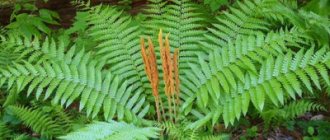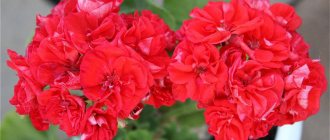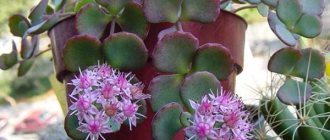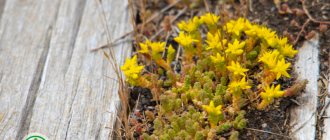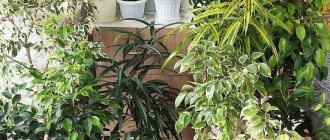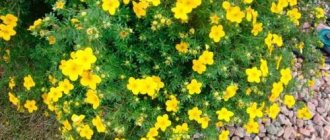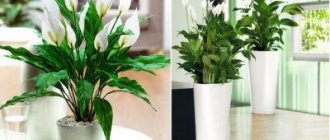In ancient times, the inhabitants of Rome believed that sedum protected buildings from lightning, so they planted it on the roofs of houses and fortifications. Sedum or sedum is a genus of succulent plants. Sedum has thick and dense stems and leaves. It has a shallow root system and sometimes long stems, thanks to which it is grown in a hanging state. Under natural conditions, it grows in the arid regions of Africa and South America, the Caucasus and some regions of Russia. There are more than five hundred species that grow at home and in open soil.
Botanical description of succulent with photo
Sedum has the following botanical characteristics:
- leaves – whole, fleshy, alternate or sessile;
- flowers are bisexual, actinomorphic, star-shaped, collected in corymbose, umbellate or racemose inflorescences, characterized by sufficient density;
- rhizome – shortened, with numerous twisted tuberous lateral roots;
- stems are strong, evenly leafy, curved at the base;
- corolla - consists of 5 free petals, approximately 3 times longer than the sepals;
- the fruit is a red or pink multileaf with numerous seeds about 1 mm long.
The height of the plant ranges from 20 to 60 cm.
Homemade sedum (sedum) - what kind of plant is it, family
The herbaceous perennial sedum sedum is a representative of the Crassulaceae family and grows in the form of shrubs, but ground cover varieties and subshrubs are often found.
Sedum, or sedum, began to be cultivated in ancient times
Brief description of what sedum looks like
The fleshy oval leaves of the bush are located evenly and alternately on the stems. The plates can be either opposite or whorled. Their size and color are also varied, as is the shape of the inflorescences.
Note! Small sedum flowers can be collected in the form of umbrella, racemose and corymbose inflorescences. The bush blooms in mid-summer and completely fades with the onset of autumn.
Medicinal properties
Due to its healing properties, sedum is widely used in folk medicine and pharmaceuticals. This herb is often grown at home for the purpose of preparing tinctures and decoctions.
Medicinal properties of sedum flower:
- normalizes blood pressure;
- fights colds;
- starts metabolism;
- reduces weight, as it is able to burn cholesterol;
- acts as a calming agent for nervous conditions.
Useful properties and contraindications
Thanks to its unique composition, sedum has many beneficial properties:
- antitumor;
- hemostatic;
- anti-inflammatory;
- stimulating;
- regenerating;
- wound healing;
- general tonic.
In addition, the use of drugs prepared on the basis of this plant has a number of healing effects on the body:
- lowering blood pressure;
- eliminating colds;
- calming the nervous system;
- weight normalization;
- normalization of the gastrointestinal tract;
- burning cholesterol.
Only sedum has contraindications. Its excessive use can cause the following symptoms:
- dizziness;
- vomit;
- cardiac and respiratory arrest (with possible coma).
The use of this type of sedum is not recommended for pregnant and lactating women, children, hypertensive patients, as well as people with increased nervous excitability.
Landing rules
For planting, it is preferable to take wide flowerpots that are small in depth, with the further possibility of hanging them, which will allow the shoots not to be injured as they grow.
When choosing a container, it is worth considering that the root system of a succulent is located superficially and rarely goes deeper into the ground by more than 10 cm.
During the event, a drainage layer is laid on the bottom of the new container. For it, it is allowed to use clay shards, crushed stone, pebbles, crushed brick, foam plastic or expanded clay as a material.
This level must be at least 3 cm in thickness and occupy a volume not exceeding ⅓ of the total. Afterwards, a small amount of substrate is distributed, the plant is installed, the voids are filled with soil and watered.
Selection of soil and location
The culture prefers loose soil, with high air and water permeability, and neutral in acidity. A universal composition for cacti and succulents is perfect for this purpose.
Sedum morgana photo
You can also prepare the substrate yourself by mixing it in the same proportions:
- coarse sand;
- peat;
- garden soil.
It is better to place the pot on a southern windowsill or hang it in close proximity to it. A location with southeast and southwest orientation will also work.
The northern side is completely unsuitable; as a result of this location, Sedum will experience elongation of shoots. At the same time, the distance between the leaf plates increases, which significantly reduces the decorative value of the crop.
Kinds
About 600 species of plants belonging to the genus Sedum are known.
Morgana
Sedum morganianum. The bluish-green leaves of this species can grow up to 1 m. The leaf blades are fleshy, pointed at the tops. The stems look like a Christmas tree. The plant is covered with a slight waxy coating that provides protection from sunburn.
Burrito
Sedum Buritto. Voluminous and low-growing bushes with rounded, fleshy greenish-blue leaves. The plant is covered with a waxy coating that performs a protective function. The flowering period is observed at the end of spring: at this time, soft pink bell buds are formed.
Despite the tight fit to the stem, the leaf blades crumble even with minor mechanical stress.
White
Sedum album. The smooth, cylindrical leaves are quite dense and fleshy. In winter and during the period of active growth, the leaf blades are colored green, and in summer and autumn they acquire a red-brown tint. The white flowers are star-shaped, small, reaching 1 cm in diameter.
Variety Coral Carpet
Of the many varieties of Sedum album, Coral Carpet stands out. The young leaves of the plant have a rich orange-coral color. The height of the peduncles reaches 15 cm, white flowers have a pink center.
Siebold
Sedum sieboldii. The plant has pink-green leaves with a red edge. Spiral-round leaf blades are impressively attached to flexible stems and are the main decoration for most of the year. The height of the bushes is about 25 cm.
The flowering period lasts from September to October and is distinguished by the formation of small dark pink buds.
Caustic
Sedum ácre. A small, bare plant with numerous stems covered with small, dense leaves and a thin rhizome. The inflorescence consists of shortened branches on which flowers with golden-yellow petals are located. Flowering period: late spring-early summer.
Red-colored
Sedum rubrotinctum. The succulent stands out for its woody stems and fleshy green leaves, reminiscent of legumes in their rounded shape. The leaf blades grow up to 2 cm in length. When exposed to sunlight, they acquire a reddish tint. During the flowering period, the plant is covered with small yellow flowers.
thick-leaved
Sedum pachyiphyllum. The upright plant is distinguished by blue-green leaves with a cylindrical shape, growing up to 2.5 cm in length. The leaf blades, folded up, are colored red at the tops. In spring, yellow flowers form on the bush.
Adolf
Sedum adolphii. The plant has light green fleshy leaves covered with a light coating. The inflorescence of white flowers is hemispherical, lateral, reaching a length of 12 cm.
In bright sunlight, the leaf blades take on a reddish tint.
Large or regular
Sedum telephium. The perennial grows up to 50 cm in height and may have one or more stems that die off in winter and emerge from the rhizome buds in the spring. On each stem there are dense, alternately arranged dense petiolate leaves. The inflorescences consist of a large number of flowers, the color of which can be pink, purple or crimson.
Common sedum is most often grown in open ground. The varieties most suitable for indoor conditions are Linda Windsor and Matrona.
Potozinsky
Sedum potosinum. Perennial succulent with creeping shoots that later rise. The leaf blades are obtuse, sessile, light green with a whitish tint. The tops of the leaf blades are pinkish-purple. During the flowering period, the plant is covered with white buds.
Steel
Sedum Stahlii. The shoots of the plant reach a height of up to 20 cm. The ovoid leaves fit tightly to the stem.
The leaf blades are red-brown in color.
Linear
Sedum lineare. A highly branching, creeping perennial has linear or linear-lanceolate leaves up to 2.5 cm long. The color of the leaf blades is light green. During the flowering period, yellow buds are formed.
Weinberg
Sedum weinbergii. A plant with recumbent and erect fleshy branches. The ovoid leaves with a pink-green tint are covered with a waxy coating. The color of the flowers is white.
Gregg's or variegated
Sedum greggii. The succulent is distinguished by gray-green leaves with an ovoid shape, twisted in an amazing way and resembling cones. During the flowering period, yellow buds form on the peduncle.
Compact
Sedum compactum. The plant has small gray-green leaves with a retracted ovoid shape. The flowering period is observed in the first half of summer: 2-3 white buds with a pleasant aroma appear on the peduncle.
Watering
Proper watering is vital to maintaining the health of indoor sedums. The soil should be checked every day by testing the moisture content with your index finger at the depth of the roots. This is approximately 2-2.5 cm below surface level.
Water only if your finger is dry. Add water until the soil is saturated with moisture and excess liquid drains from the drainage holes.
How to water a flower in winter? At this time, water less frequently and allow the soil to dry completely. Sedum leaves will tell you when to water. If they begin to wrinkle slightly, it is time to water.
Home care
Most types of sedums are unpretentious. However, caring for them requires following basic rules.
Temperature
Recommended temperature in summer is +25-28 degrees, in winter – +14-18 degrees.
Location and lighting
Sedum is a light-loving plant that needs bright sunlight. Therefore, to place it, you should choose windows facing south.
In winter, the succulent requires lighting.
Watering and spraying
Sedum stores water in its fleshy leaves and slowly evaporates it. Therefore, watering should be quite moderate: in summer - once a week, in winter - 2 times a month. Occasionally, the plant can be sprinkled with warm water to wash away dust and other contaminants.
Choosing a pot or flowerpot
Due to the small root system of sedum, low, wide containers equipped with a drainage system are well suited for its cultivation. Since the plant's roots develop slowly, it is not necessary to change the pot to a larger one when replanting.
Priming
To plant sedum, you can purchase a ready-made substrate for succulents or prepare it yourself using the following components:
- leaf soil (1 part);
- turf (1 part);
- sand (1 part);
- charcoal;
- crushed brick.
Another recipe includes the following components: sand, humus and peat, taken in a ratio of 1:1:2.
Flowering and dormant period
During the flowering period, sedum requires a large amount of sunlight. Therefore, it is best to take a flower grown indoors to a balcony or veranda. During the dormant period, it is better to leave it in a room with a temperature of no more than +18 degrees, reducing watering and completely abandoning fertilizing.
Landing
The frequency of replanting a young plant is once every 2 years, an adult plant is once every 3-4 years. The procedure should be performed as carefully as possible due to the fragility of the sheet plates.
Top dressing
Sedum is fed from the beginning of spring until the first half of autumn. For this purpose, special formulations for cacti are used, which are applied once a month. During the dormant period, the plant does not need fertilizing.
How to propagate?
There are several ways to propagate sedum: by leaf, by dividing the bush, by seeds, by cuttings. The last two are considered the most common.
From seeds
This technology allows you to simultaneously grow a large number of sedums. The procedure is carried out in spring or autumn. The seeds are mixed with dry sand, placed in pre-moistened soil, and then a small greenhouse is set up. With proper care, the first shoots appear within 2 weeks.
How to root cuttings in the fall?
Planting cuttings must be carried out immediately after cutting.
It is advisable to carry out the procedure in the fall. Planting material is planted in a light and loose substrate, using a wide but low bowl. Rooting will occur in approximately 14-20 days, and after another 2 weeks, young plants are planted in separate containers.
Diseases and pests
With proper care, it is rarely susceptible to disease. However, if the watering regime is violated, the underground and above-ground parts of the plant are affected by various fungi. To eliminate the problem, damaged specimens are dug up and treated with fungicides.
Harmful insects love the lush greenery of the succulent and attack it throughout the growing season. Particularly often attacked:
- aphid;
- thrips;
- grooved mower;
- caterpillars;
- sawflies.
The collected insects are destroyed, and the bushes are treated with acaricides or insecticides.
Also, such folk remedies as tincture of marigold, tansy, dandelion, nettle, and tree bark give good results.
Reproduction
Sedum propagates by seeds, but there is no point in messing with them, since the plant is easy to propagate by cuttings at any time of the year, and not necessarily from the apical ones. You can get a lot of plants from one stem.
- Broken pieces of stems or leaves of many species, falling on the ground, often take root on their own.
- Cuttings easily root in sand, perlite or their mixture with peat. Before rooting, they need to be dried from several hours to several days.
- When transplanting, you can divide an overgrown plant.
Growing in open ground
Sedum bushes are frost-resistant and are well suited for growing in areas with infertile soil. An important condition for the successful growth of perennials is well-drained soil. The recommended time for planting is April and May.
During the growing process, the sedum is watered moderately and fed with compounds for garden plants. Weed as necessary. In the spring, after the first frost has passed, the plant is pruned.
Despite its frost resistance, it is recommended to protect the plant from exposure to low temperatures by creating a shelter for it from fallen leaves, pine branches or agrofibre.
Possible difficulties
- Mealybug. The pest attacks the leaf axils. It is necessary to remove insects using a cosmetic stick, after which the plant is treated with an insecticide.
- Wilting of leaves. Indicates insufficient watering.
- Rotting of the roots and base of the stem. Indicates that the soil is too wet and the temperature is low. You should moderate watering and move the plant to a warmer place.
- Falling leaves after transplantation. This is a natural manifestation of the plant's establishment in new soil. It is necessary to give the sedum time to recover.
- Pulling out internodes. This happens due to a lack of lighting. The plant is moved to a sunnier place or kept under a lamp for some time.
Such an unpretentious plant as sedum burrito can be mastered even by a novice gardener. By following simple rules of care, you can add this unusual representative of succulents to your collection of decorative favorites for many years.
Useful video
How to properly prune a plant when it begins to stretch, watch the video:
Original compositions from sedum can be created both in personal plots and in residential or office premises. With timely and proper care, the plant will delight you with its beauty for many years.
READ ABOUT OTHER SUCCULENTS: GASTERIA, COTYLEDON, GRASSWORTH, LITHOPS, REJUVEN, a href=”https://botanicoved.com/komnatnye/sukkulenty/raznovidnosti-sukkulenty/pahifitum.html” rel=”noopener” target=”_blank”> PACHYPHYTUUM, PORTULACARIA, SEDEVERIA, STAPELIA, HAWORTIA, EONIUM, ECHEVERIA.
Features of cuttings
Sedums are propagated by leaf and stem cuttings, usually in the warm season. The most suitable seasons for this procedure are spring and autumn. Experienced plant growers recommend harvesting cuttings before the succulent blooms (in spring) or after it (in autumn). It is not advisable to use flowering, weakened, damaged or very young plants, less than three years old, for cuttings.
It is prepared in advance from turf soil, leaf humus, peat soil and sand (recommended proportions are 1:1: 1:1). It is also possible to use ready-made store-bought substrates recommended for growing succulents. Before filling the pot with soil, it is necessary to lay a layer of drainage on the bottom of the container: river pebbles, pieces of expanded clay or polystyrene foam.
Cuttings are carried out as follows:
- choose the strongest, well-developed above-ground shoot on the sedum;
- break off or separate with scissors the upper part of the shoot 5-6 centimeters long;
- remove a couple of lower leaves from the cutting;
- treat the cut site on the mother plant with charcoal powder.
The prepared cutting is placed in a container or cup with soil mixture. The lower part of the shoot is buried 1.5-2 centimeters into the ground. After planting, the cuttings are thoroughly watered.
Watering is carried out as the surface of the soil in the container dries. Successful rooting will be indicated by the gradual growth of cuttings and the formation of new leaves on them.
You can root a sedum cutting in a glass of water. Some gardeners pre-treat the lower cut of the shoot with root formation stimulants (Kornevin, Epin). If the procedure is carried out correctly, the roots of the cuttings appear after 2-3 weeks.
Leaf cuttings of sedums are rooted in the same way. To do this, use healthy leaves from mature plants. Many varieties of sedum reproduce independently by leaves. After falling, the leaves of such plants take root safely in the pot with the mother bush without outside intervention.
To root sedum leaves, they must be spread on the surface of a moist, loose substrate. Some gardeners slightly bury the lower cut of the leaves (or their petioles) into the ground
During the process of rooting leaves, it is important to ensure that the surface of the substrate does not dry out.
Flower growers recommend rooting stem and leaf cuttings at room temperatures within +20-23°. During the rooting period, cuttings should be kept in a bright, draft-free room. It is not allowed to place rooting planting material in direct sunlight.
After harvesting, the cuttings are laid out on sheets of paper and sent to a dry room. After 2-4 weeks, the leaves of the cuttings will fall, after which young green shoots will begin to appear in their axils. When the shoots reach a length of 4-6 centimeters, they are separated from the cuttings and planted in boxes with loose substrate.

